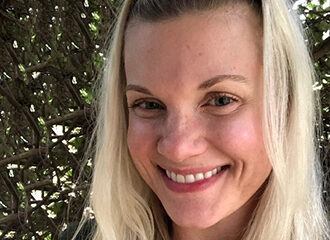Written by: Christina Purkiss, MA, LMHC, CEDS-S (she/her/hers)
Assistant Vice President at The Renfrew Center
Clear relationship boundaries are critical to effective eating disorder recovery. In this post, we look at the 4 essential guidelines to help you identify and communicate your needs.
 Boundaries can be physical or emotional limits we set to support and protect our relationships and our well-being. They are key in building and maintaining healthy relationships, but oftentimes knowing how to set a boundary can be a challenge.
Boundaries can be physical or emotional limits we set to support and protect our relationships and our well-being. They are key in building and maintaining healthy relationships, but oftentimes knowing how to set a boundary can be a challenge.
Relationship Boundaries & Eating Disorders: 4 Guidelines
It’s not uncommon to discover unhealthy relationship patterns that you have fallen into throughout the course of an eating disorder. How to develop new, more productive patterns may be one of the many things you explore in recovery and part of that work usually includes setting and maintaining boundaries. Below we’ll review a few tips on how to identify and communicate boundaries while navigating eating disorder recovery.
#1 – Identify your needs and emotions within your relationships
To start, it is useful to identify the relationships in your life and consider the different needs you have within each relationship. What you need from a family member will be very different than what you need from a co-worker.
It’s also helpful to notice the feelings that arise in these relationships, as our emotions will often alert us when a need is not being met. For instance, maybe you have a co-worker or peer at school who frequently engages in diet talk or who talks negatively about their body, and you notice feelings of anxiety heighten. An appropriate boundary might be requesting that person to avoid diet and body talk while they are with you.
Alternatively, maybe you have a family member who tries to offer you a solution when they notice you experiencing a distressing emotion, or an eating disorder urge. Although it is often well-intended, offering a solution when feeling emotional distress can feel invalidating. An appropriate boundary might include expressing what you truly need in these moments and requesting that your family member simply listen and validate instead of trying to “fix” things for you.
#2 – Communicate your boundaries
You may want to set a boundary, but stating the boundary out loud can feel intimidating! You may benefit from writing the boundary down on paper or verbalizing your boundary with a close support person or someone on your treatment team. When sharing your boundaries, try to be firm. You do not need to apologize for setting boundaries either!
Remember, we all need boundaries in relationships. You are not doing anything wrong by requesting that someone avoids a conversation topic or provides you a different type of support. Rather, you are working toward creating a healthier relationship and more sustainable patterns.
#3 – Getting comfortable with ways to say “no”
You may be someone who frequently says “yes” to others even when it comes at your expense. Perhaps you are someone who is always willing to inconvenience yourself for the sake of helping out a friend or family member. Maybe you find yourself constantly giving to others even when you are feeling depleted inside and need time to rest and recharge.
The thought of saying “no” to someone can feel uncomfortable especially if you identify as being a people pleaser. The reality is that we all have limits on how much we can give, so declining a request or passing on an invitation can be beneficial for your relationship and your wellbeing.
One way to set a boundary is to simply say, “no”, but another way is to identify and express your own needs that interfere with your ability to authentically and whole-heartedly say “yes”.
Remember that it is important to recognize, honor, and attend to your own needs, even when you run the risk of someone feeling hurt of upset. If the relationship is important to you, consider creating the space to openly talk about and validate the emotions and needs underneath their request. Your job is to identify your needs and set your boundaries, not to prevent or protect the other person from having their own emotional experiences.
#4 – Speak up when a boundary is crossed
If you notice a boundary is crossed, or seemingly forgotten, it can be useful to remind the person of the boundary. In a trusting relationship, you might also express the needs behind that boundary and the emotions that arise when the boundary is crossed.
While those reminders may be needed, you also may start to recognize that some individuals do not show respect for your boundaries, or constantly violate them. If that occurs, it may be time to re-evaluate if that relationship is serving you.
Is this someone who is supportive to your recovery process or your overall wellbeing?
Is this a growth fostering relationship?
If the answer is no, perhaps the work becomes distancing yourself from that person and nurturing the more supportive relationships in your life. These can be tough questions to answer, so it may be useful to explore this with a therapist or a trusted loved one.
Conclusion
As you and your needs change and evolve through your eating disorder recovery process, your relationships may also change and evolve. As those changes occur your boundaries may need to be revisited. You may realize you need to loosen a boundary or make it more rigid. Periodically reassessing boundaries is important work. Don’t forget to lean on your treatment team members such as a therapist to help you navigate this process. If you do not have a team, you can explore these topics with a safe and trusted support person. Setting boundaries can be challenging, but with continued effort and practice it will become easier and ultimately lead to healthier, more fulfilling relationships.
Sources:
- Rosenberg, M. B. (2003). Nonviolent communication: a language of life. 2nd ed. Encinitas, CA, PuddleDancer Press



